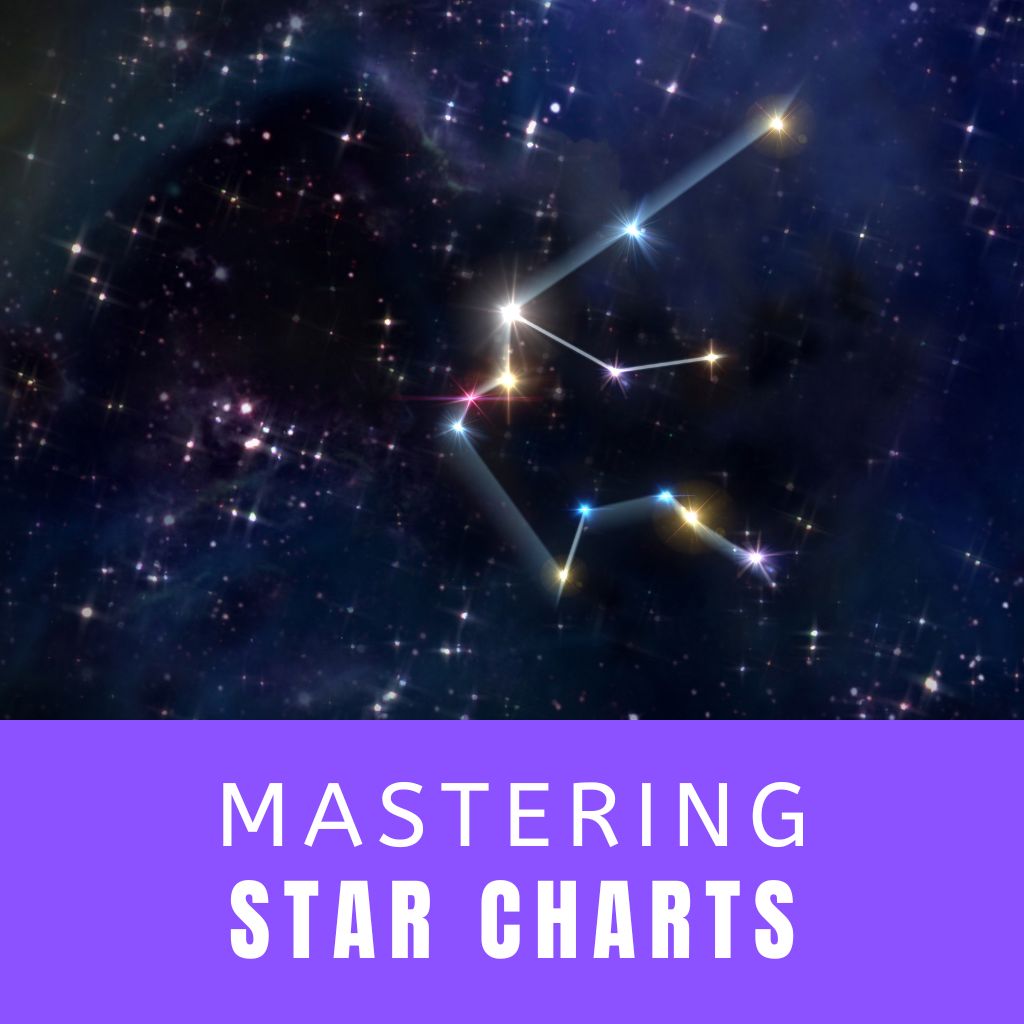This site contains affiliate links to products. I may receive a commission for purchases made through these links.
Ever looked up at the night sky and wondered what you’re seeing? I did too, until I discovered star charts. These fascinating maps of the heavens can help you identify constellations, planets, and other celestial objects. They’re a must-have for any aspiring astronomer or casual stargazer.
But let’s face it – star charts can be a bit intimidating at first. They’re packed with symbols and lines, and it’s not always clear how to read them. That’s where I come in. In this beginner’s tutorial, I’ll break down the basics of mastering star charts.
What are Star Charts?
Let’s dive deeper into understanding what star charts are. Often referred to as sky maps, star charts are tools used by both amateur stargazers and professional astronomers alike. They provide a visual representation of stars, constellations, and other celestial bodies as seen from Earth.
There’s a diverse range of star charts, from simple sky maps that highlight major constellations to detailed charts used by pros to locate obscure celestial objects. Star charts can be geographic, denoting the night sky as viewed from specific locations. Others are designed around particular times, illustrating the sky as it appears during different hours or seasons.
What’s captivating about these maps is their transformation over time. In the past, we relied on rudimentary star maps drawn onto parchment or carved into stone. But modern technology has ushered in digital star charts. Today, dedicated software and apps offer interactive features, allowing us for real-time observation and study of space.
This might sound overwhelming but don’t fret, I’m here to guide you through it all. Moving forwards, we’ll explore various types of star charts and discuss how to read and interpret them. Bearing in mind, each one serves a distinct purpose and will be more effective depending on your stargazing goals. Before we venture into that vast cosmos, take a moment to familiarize yourself with the concept – remember, Rome wasn’t built in a day, and mastering the stars won’t happen overnight. But with a little patience and persistence, you’ll be navigating the night sky like you were born to it.
Why Use Star Charts?
I often get asked, “Why should we use star charts?” It’s a valid question. Astronomical charts, or star charts as they’re often called, are crucial tools in both amateur and professional stargazing. Here’s why.
Clarity in Observation: Star charts provide a labeled and structured view of the night sky. You can identify celestial bodies, their positions, and even their movement patterns. Many star charts also indicate the brightness of stars, making your observations more accurate.
Navigational Aid: Ever heard the stories of sailors navigating their way through the seas using just the stars? That’s where a star chart comes in handy – as a tool for celestial navigation. It simplifies the complex task of direction finding in the absence of reliable land markers.
Education and Research: For students and researchers, star charts serve as invaluable resources. These charts let you study and compare different celestial bodies, patterns, or celestial events–like meteor showers or eclipses. They’re a means to better understand our universe.
Astronomy Appreciation: Lastly, star charts can simply be appreciated for their beauty and historical significance. They’ve evolved from simple hand-drawn maps to sophisticated digital versions that visualize the cosmos in remarkable detail.
While astronomy apps and websites may provide convenience, there is a certain charm and hands-on learning experience that comes with using traditional star charts. My advice is to try them out. They just might help you appreciate the beauty and vastness of the cosmos a bit more.
There are a few types of star charts that you’ll encounter as you delve into stargazing which we’ll cover in the next section, “Types of Star Charts”.
The Basics of Star Chart Reading
Navigating the universe’s vast expanse using paper maps might seem archaic in this day and age. But you’ll soon learn, nothing beats the hands-on experience a star chart brings. So, let’s dive into the basics of reading these stargazing guides.
A star chart – or sky map – is primarily a circular map. The circle’s outer edge represents the horizon. Everything inside the circle reflects the part of the night sky you can currently see.
When you hold the chart over your head, the sky should appear to align with the stars and celestial objects on the map. Each star chart is location and time-specific – designed for a particular latitude at a given time and date.
Deciphering Celestial Mathematics
Star charts depict three vital celestial elements: Right Ascension (RA), Declination, and Magnitude.
- Right Ascension (RA) is similar to longitude on Earth, providing an object’s east-west location. It’s measured in hours, minutes, and seconds.
- Declination corresponds to latitude in terrestrial terms, indicating a celestial body’s north-south position. It’s measured in degrees.
- The Magnitude of a celestial object signifies its brightness. The lower the number, the brighter the star.
Here’s a handy markdown table to encapsulate these concepts:
| Celestial Element | Terrestrial Correlation | Unit of Measurement |
|---|---|---|
| Right Ascension (RA) | Longitude | Hours, minutes, seconds |
| Declination | Latitude | Degrees |
| Magnitude | N/A | Numerical (Lower is brighter) |
Star Chart Symbols
Each symbol you observe on a star chart carries a particular implication. Circles typically denote stars, with the circle’s size correlating to the star’s brightness. The more giant the circle, the brighter the star.
Lines connect many of these circles, forming constellations.
Various other figures like crosses, squares or triangles signify different celestial objects like galaxies, star clusters or nebulae.
In the next section, we’ll be delving deeper into the advanced techniques of star chart reading, helping you become a seasoned stargazer in no time.
Understanding Constellations
As we continue on our stargazing journey, it’s time we venture into territories that often leave beginners bewildered and intrigued – Constellations. At the core, constellations are just a group of stars that form an imaginary pattern in the night sky. They’re kind of like stellar jigsaw puzzles!
Historically, different cultures have envisioned various shapes leaning heavily on myths, folklore, and their collective imagination. Nowadays, there are officially recognized 88 constellations. That may sound like a lot, but don’t worry. Just like every new skill, acclimating to the stars also takes time.
To identify constellations, you should familiarize yourself with a few crucial ones first. The ‘Big Dipper’ or Ursa Major is a great starting point, easily visible and recognizable throughout the northern hemisphere. Once you get the hang of it, finding other constellations becomes more comfortable. I also highly recommend Polaris, the North Star. It’s part of the Little Dipper, or Ursa Minor, and is a useful reference point due to its location near the North Celestial Pole.
Most star charts will display these constellations to aid in your celestial navigation. Often, they use lines to connect major stars fostering an easier visualisation of the pattern. They also typically provide the Latin names in addition to the common titles.
Remember, your star chart is specific to your location and time. So the depiction of constellations on your chart is what you should see in your night sky at a particular place, date, and time. If you’re viewing from a different place or time, switch your chart to match your new parameters.
Identifying Planets and Other Celestial Objects
Once you’ve grasped the basics of star chart reading and constellation recognition, your next step in mastering star charts is to learn how to identify other celestial objects such as planets, meteors, and comets. It may seem like a daunting task, but don’t worry! With a bit of patience and practice, you’ll be spotting these celestial wonders in no time.
Understanding Planet Positions
Planets differ from stars in that they don’t have fixed positions on the star chart. Their positions change gradually over time due to their orbits around the Sun. This means a planet’s location on a star chart is date and time-specific. Be sure to keep your star chart updated to stay accurate with shifting planetary positions.
Recognizing Planets on Star Charts
Planets on star charts are typically denoted by specialized symbols. These symbols are derived from ancient astrological signs and may vary slightly depending on the specific star chart you use. For instance, Mercury is often represented by ☿, Venus by ♀, Mars by ♂, Jupiter by ♃, and so on.
Identifying Meteors and Comets
Meteors, also known as “shooting stars,” are typically represented on star charts as tiny streaks. Smaller than the symbols used for stars or planets, making them out requires precision and keen observation.
Comets, on the other hand, are usually represented by their names, written on the path they’re expected to travel on the chart. Remember, comet paths can sometimes change, so it’s always a good idea to keep an eye on updates.
Reading Magnitude Data
Star charts also provide information on Magnitude — a measure of the brightness of a celestial body. It’s important to familiarize yourself with these figures to understand what you can and can’t see with the naked eye or with your specific telescope.
These are the essential pointers you need to start identifying planets and other celestial objects in the night sky using star charts. Keep practicing, stay patient and remember — the sky’s not the limit, it’s the destination.
Tips for Using Star Charts
Even though star charts might seem like complex tools to use, with some practice, they can become your best friend in navigating the night sky. Here are some essential tips on how to make the most out of the star charts.
Understanding Your Location
Location is key in using star charts effectively. Since they’re designed to mirror the night sky as it appears to the observer, knowing your geographical coordinates will ensure you get the most accurate view. Whether you’re in Urumqi or Utah, you need to know your latitude and longitude.
Time Matters
Star charts are also time-sensitive. Understanding the rotation of the Earth and how it influences the night sky is critical. Keep in mind that what you see at 9 PM tonight won’t look the same at the same time next month. Updating the star chart according to the date and time will aid in your celestial navigation.
Weather Conditions
Don’t forget, our planet’s atmosphere also plays a part in what you can see. Weather conditions, such as cloud coverage, can obscure certain celestial objects. You might not be able to observe a particular constellation or comet if the weather isn’t cooperating. But don’t be discouraged – it can be thrilling to finally spot that elusive celestial body once the clouds part!
Magnitudes
Remember, grasping magnitude data is crucial. Magnitudes tell us how bright or dim a celestial object will seem from Earth. By understanding magnitude, you’ll quickly realize why some stars shine brighter than others.
Practice Makes Perfect
Finally, practice is key for mastering star charts – and that’s all part of the fun. Start by familiarizing yourself with a few core constellations and prominent stars and gradually increase your knowledge. Stellar exploration is a journey, not a destination. The more you explore, the more fascinating celestial objects you’ll uncover.
In my experience, immersing myself in the vast realm of the night sky has been intensely rewarding. May your journey exploring the celestial sphere be filled with wonder, discovery, and fun! Is there anything more exciting than unveiling the treasures of the universe?
Conclusion
There’s no doubt that mastering star charts can significantly enhance your stargazing experience. They’re not just tools but gateways to the wonders of the cosmos. As you’ve learned, location, time, weather, and magnitude data all play key roles in reading star charts effectively. But don’t forget – practice makes perfect. The more you use star charts, the better you’ll become at navigating the night sky. So grab your star chart, step outside, and let the universe unfold before your eyes. Here’s to clear skies and new discoveries!



